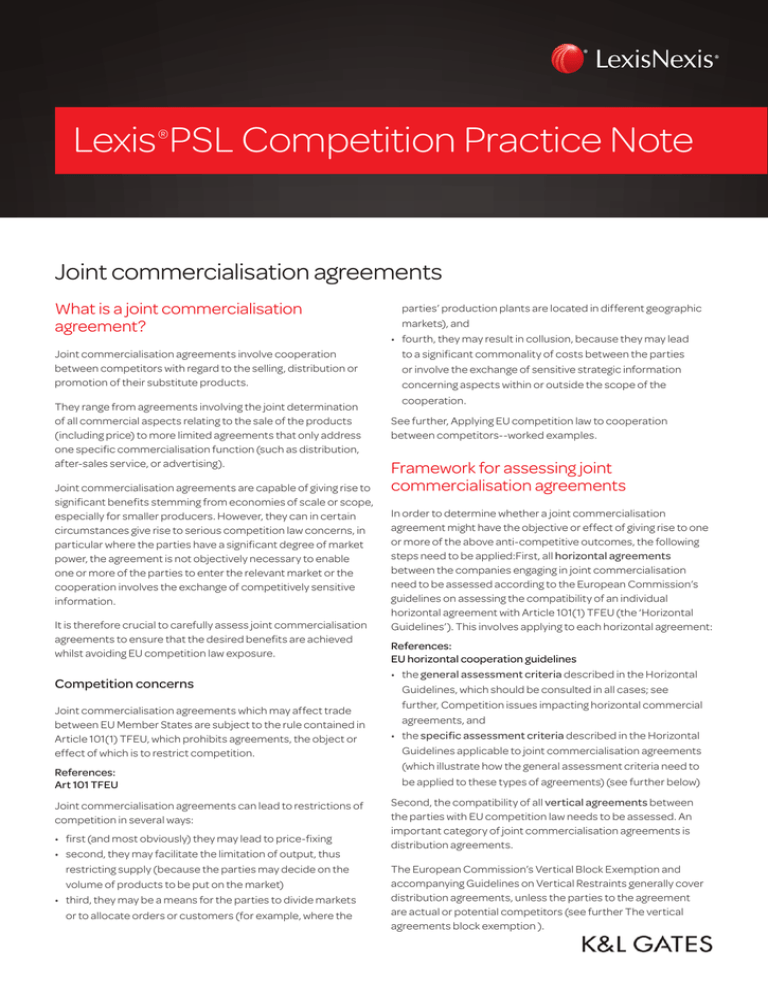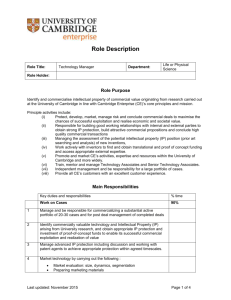Joint commercialisation agreements What is a joint commercialisation agreement?
advertisement

Lexis PSL Competition Practice Note ® Joint commercialisation agreements What is a joint commercialisation agreement? Joint commercialisation agreements involve cooperation between competitors with regard to the selling, distribution or promotion of their substitute products. They range from agreements involving the joint determination of all commercial aspects relating to the sale of the products (including price) to more limited agreements that only address one specific commercialisation function (such as distribution, after-sales service, or advertising). Joint commercialisation agreements are capable of giving rise to significant benefits stemming from economies of scale or scope, especially for smaller producers. However, they can in certain circumstances give rise to serious competition law concerns, in particular where the parties have a significant degree of market power, the agreement is not objectively necessary to enable one or more of the parties to enter the relevant market or the cooperation involves the exchange of competitively sensitive information. It is therefore crucial to carefully assess joint commercialisation agreements to ensure that the desired benefits are achieved whilst avoiding EU competition law exposure. Competition concerns Joint commercialisation agreements which may affect trade between EU Member States are subject to the rule contained in Article 101(1) TFEU, which prohibits agreements, the object or effect of which is to restrict competition. References: Art 101 TFEU Joint commercialisation agreements can lead to restrictions of competition in several ways: • first (and most obviously) they may lead to price-fixing • second, they may facilitate the limitation of output, thus restricting supply (because the parties may decide on the volume of products to be put on the market) • third, they may be a means for the parties to divide markets or to allocate orders or customers (for example, where the parties’ production plants are located in different geographic markets), and • fourth, they may result in collusion, because they may lead to a significant commonality of costs between the parties or involve the exchange of sensitive strategic information concerning aspects within or outside the scope of the cooperation. See further, Applying EU competition law to cooperation between competitors--worked examples. Framework for assessing joint commercialisation agreements In order to determine whether a joint commercialisation agreement might have the objective or effect of giving rise to one or more of the above anti-competitive outcomes, the following steps need to be applied:First, all horizontal agreements between the companies engaging in joint commercialisation need to be assessed according to the European Commission’s guidelines on assessing the compatibility of an individual horizontal agreement with Article 101(1) TFEU (the ‘Horizontal Guidelines’). This involves applying to each horizontal agreement: References: EU horizontal cooperation guidelines • the general assessment criteria described in the Horizontal Guidelines, which should be consulted in all cases; see further, Competition issues impacting horizontal commercial agreements, and • the specific assessment criteria described in the Horizontal Guidelines applicable to joint commercialisation agreements (which illustrate how the general assessment criteria need to be applied to these types of agreements) (see further below) Second, the compatibility of all vertical agreements between the parties with EU competition law needs to be assessed. An important category of joint commercialisation agreements is distribution agreements. The European Commission’s Vertical Block Exemption and accompanying Guidelines on Vertical Restraints generally cover distribution agreements, unless the parties to the agreement are actual or potential competitors (see further The vertical agreements block exemption ). Joint commercialisation agreements References: Regulation 330/2010 EU vertical restraints guidelines If the parties are actual or potential competitors: • the Vertical Block Exemption only covers ‘non-reciprocal’ distribution agreements (ie where the parties do not agree to distribute their substitute products on a reciprocal basis) where: • the supplier is both a manufacturer and a distributor of goods, while the buyer is a distributor and not a competing undertaking at the manufacturing level, or • the supplier is a provider of services at several levels of trade, while the buyer provides its goods or services at the retail level and does not provide competing services at the level of trade where it purchases the contract services References: EU horizontal cooperation guidelines, para 226 • the Vertical Block Exemption does not cover non-reciprocal agreements between competitors that do not fall within one of the categories described at (a) above. Non-reciprocal distribution agreements between competitors not falling under (a) above need to be assessed according to the principles in the Horizontal Guidelines References: EU horizontal cooperation guidelines, para 227 • the Vertical Block Exemption does not cover reciprocal agreements between competitors (ie where competitors agree to distribute their substitute products on a reciprocal basis, in particular if they do so on different geographic markets). These also need to be assessed according to the principles in the Horizontal Guidelines References: EU horizontal cooperation guidelines, para 227 • Vertical agreements between competitors falling within the second or third bullet points above need to be assessed under the Horizontal Guidelines because there is a possibility that they have as their object or effect the partitioning of markets between the parties or could lead to a collusive outcome. See further Competition issues impacting vertical commercial agreements. Application of specific assessment criteria under Horizontal Guidelines Assessment under Article 101(1) TFEU Article 101(1) TFEU prohibits restrictions of competition by object or effect. Restrictions of competition by object Agreements between competitors which involve the fixing of purchase prices, allocation of markets or limitations on output (so-called ‘hardcore restrictions’) will generally be found to have as their object the restriction of competition within the meaning of Article 101(1) TFEU. The Horizontal Guidelines identify agreements limited to joint selling as particularly likely to give rise to the risk of illegal pricefixing. This is because such agreements generally have the object of coordinating the pricing policy of competing manufacturers or service providers, and are regarded as having the potential both to eliminate price competition between the parties and to restrict the total volume of products to be delivered by the parties. Such agreements are likely to be considered restrictions by object even where they are non-exclusive (that is, where the parties are free to sell individually outside the agreement), if it is found that the agreement will lead to an overall coordination of the prices charged by the parties. References: EU horizontal cooperation guidelines, paras 234 and 235 In addition, distribution agreements between parties active in different geographic markets are identified in the Horizontal Guidelines as particularly at risk of being used as ‘instrument(s) of market partitioning’. This risk will be especially pronounced in the case of reciprocal distribution agreements, which are likely to have as their object a restriction of competition if reciprocal distribution by the parties is used as a means of eliminating actual or potential competition between them by deliberately allocating markets or customers. Although the risk is ‘less pronounced’ in the case of non-reciprocal distribution agreements, it is necessary always to assess whether the non-reciprocal agreement ‘constitutes the basis for a mutual understanding to avoid entering each other’s markets’. References: EU horizontal cooperation guidelines, para 236 See further, What is the object test?. Restrictions of competition by effect The Horizontal Guidelines provide that joint commercialisation agreements which do not have as their object the restriction of competition must still be analysed in their legal and economic context to determine whether they are likely to give rise to any restrictive effects on competition. This analysis must be carried out in respect of both the market(s) to which the relevant products belong and any closely-related neighbouring market(s) (which may be horizontally or vertically related) in which the competitive behaviour of the parties may be affected. The key questions to be asked in this analysis are: • whether the parties have sufficient market power for their joint commercialisation to negatively affect competition in any markets • if so, whether the joint commercialisation agreement is ‘objectively necessary’ for the parties to enter the relevant market(s), and • whether the agreement gives rise to the risk of collusion between the parties Market power The Horizontal Guidelines recognise that joint commercialisation agreements between competitors can only have restrictive effects Joint commercialisation agreements on competition if the parties have some degree of market power. In most cases, it is unlikely that market power exists if the parties to the agreement have a combined market share not exceeding 15%. References: EU horizontal cooperation guidelines, para 240 Where the parties have a combined market share exceeding 15%, it does not automatically mean that the agreement is anticompetitive, however it will fall outside safe harbour and its likely impact on the market(s) concerned will need to be individually assessed taking into account the general assessment criteria described in the Horizontal Guidelines (see further, Competition issues impacting horizontal commercial agreements) and the considerations outlined below. Agreement is objectively necessary EU competition law accepts that a joint commercialisation agreement will generally not give rise to competition law concerns if it is ‘objectively necessary to allow one party to enter a market it could not have entered individually or with a more limited number of parties... for example, because of the costs involved’. For instance, in the case of a consortia arrangement where market players come together to carry out a project, if the parties are not genuinely potential competitors for implementing that project (because they would not have been able to carry it out individually), restrictive effects on competition are unlikely. References: EU horizontal cooperation guidelines, para 236 Similarly, in the case of a distribution agreement, it needs to be assessed whether the agreement is objectively necessary for the parties to enter each other’s markets. If so, it is not likely to give rise to anti-competitive effects within the meaning of Article 101(1) TFEU. However, if it reduces one party’s decision-making independence with regard to entering the other party’s market(s) by limiting its incentives to do so, it is likely to give rise to anticompetitive effects. References: EU horizontal cooperation guidelines, para 236 It is also important to review vertical commercialisation agreements (eg distribution agreements) for vertical restraints, such as resale price maintenance, restrictions on passive sales, and so on, which can give rise to restrictive effects on competition. Risk of collusive outcome A number of factors need to be considered in determining the likelihood of collusion. These include the commonality of costs between the parties (against the background of their market shares and the market characteristics) and the degree of exchange of sensitive information between the parties. Commonality of costs. Even if a joint commercialisation agreement does not involve price-fixing, it is likely to give rise to restrictive effects on competition if it increases the parties’ commonality of variable costs to a level which is likely to lead to a collusive outcome. The Horizontal Guidelines indicate that this is likely to be the case if: • prior to the agreement the parties already had a high proportion of their variable costs in common, because the additional increment (ie the commercialisation costs of the product subject to the agreement) ‘can tip the balance towards a collusive outcome’, or • conversely, the increment is large, in which case the risk of collusion may be high even if the initial level of commonality of costs is low References: EU horizontal cooperation guidelines, para 242 However, the Horizontal Guidelines accept that a commonality of costs is only likely to increase the risk of a collusive outcome where: • the parties have market power, and • the commercialisation costs constitute a large proportion of the variable costs related to the products concerned. This would generally not be the case for homogeneous products, the highest cost factor of which constitutes production. However, it is likely to be an issue where the products concerned involve high commercialisation costs, such as costs of joint distribution, marketing, advertising and so on References: EU horizontal cooperation guidelines, para 243 Exchange of information. Joint commercialisation agreements will generally involve some exchange of sensitive commercial information, in particular concerning the parties’ marketing strategies and pricing. EU competition law recognises that ‘some degree of information exchange’ is required in order to implement a commercialisation agreement. However, it is essential to determine in each case whether the information exchange is capable of giving rise to a collusive outcome with respect to the parties’ activities within and outside the cooperation, and in particular whether it goes beyond what would be necessary to implement that agreement. The likely restrictive effects on competition of information exchange will depend on the characteristics of the market and the nature of the information shared, and should be assessed in the light of the guidance given in Chapter 2 of the Horizontal Guidelines (concerning information exchange). However, any negative effects arising from the information exchange will not be assessed separately but in the light of the overall effects of the commercialisation agreement. References: EU horizontal cooperation guidelines, para 245 Assessment under Article 101(3)TFEU If an agreement is found to be restrictive of competition within the meaning of Article 101(1) TFEU, it is necessary to determine Joint commercialisation agreements whether it produces any pro-competitive benefits and to assess whether those pro-competitive benefits outweigh the restrictive effects on competition. The balancing of restrictive and pro-competitive effects is conducted exclusively within the framework laid down by Article 101(3) TFEU. If the pro-competitive effects do not outweigh restrictions of competition, Article 101(2) TFEU stipulates that the agreement shall be automatically void. References: Art 101(3) TFEU For the general principles as to how to assess an agreement under Article 101(3) TFEU see Competition issues impacting horizontal commercial agreements. With respect to the specific principles applicable to commercialisation agreements, the Horizontal Guidelines provide the following: • the efficiencies to be taken into account when assessing whether an agreement fulfils the criteria of Article 101(3) TFEU will depend on the nature of the activity and the parties to the cooperation: References: EU horizontal cooperation guidelines, para 246 • price-fixing will generally not be justifiable, unless it is ‘indispensable for the integration of other marketing functions, and this integration will generate substantial efficiencies’ References: EU horizontal cooperation guidelines, para 246 • the efficiency gains must result from the integration of the parties’ economic activities. They cannot be savings which result only from the elimination of costs that are ‘inherently part of competition’. For example, a reduction in transport costs which results from customer allocation without any integration of the logistical system will not be regarded as an efficiency gain within the meaning of Article 101(3) TFEU References: EU horizontal cooperation guidelines, para 247 • the parties must be able to demonstrate any apparent efficiency gains, for example show the contribution by the parties of significant capital, technology, or other assets, or cost savings achieved through reduced duplication of resources and facilities. If the joint commercialisation agreement represents ‘no more than a sales agency without any investment, it is likely to be a disguised cartel and as such unlikely to fulfil the conditions of Article 101(3)’ References: EU horizontal cooperation guidelines, para 248 • any restrictions must be indispensable to achieving the efficiency gains. This factor is particularly important in respect of joint commercialisation agreements involving price-fixing or market allocation, which can only be considered indispensable ‘under exceptional circumstances’ References: EU horizontal cooperation guidelines, para 249 • the efficiency gains must be passed on to consumers to an extent that outweighs the restrictive effects on competition, for example, in the form of lower prices or better product quality or variety. This requirement is less likely to be met the higher the parties’ market power, and References: EU horizontal cooperation guidelines, para 250 • finally, the criteria of Article 101(3) TFEU will not be fulfilled if the parties are afforded the possibility of eliminating competition in respect of a substantial part of the products in question (either in the market to which the products belong or any neighbouring markets) See further, Individual Exemptions under Article 101(3) TFEU. Joint commercialisation agreements can be very beneficial for consumers and markets, as well as the parties concerned. However, a joint commercialisation agreement (or important parts of it) found to be restrictive of competition within the meaning of Article 101(1) TFEU, which is or are not saved by Article 101(3) TFEU, will be automatically void and unenforceable. Reed Elsevier (UK) Limited trading as LexisNexis. Registered office 1-3 Strand London WC2N 5JR Registered in England number 2746621 VAT Registered No. GB 730 8595 20. LexisNexis and the Knowledge Burst logo are trademarks of Reed Elsevier Properties Inc. © LexisNexis 2015 0815-011. The information in this document is current as of August 2015 and is subject to change without notice.





